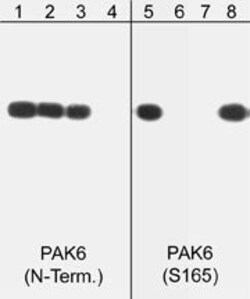Learn More
Invitrogen™ Phospho-PAK6 (Ser165) Polyclonal Antibody
Rabbit Polyclonal Antibody
Supplier: Invitrogen™ PA5143735
Description
This antibody was cross-adsorbed to unphosphorylated PAK6 (Ser-165) peptide then affinity purified using phospho-PAK6 (Ser-165) peptide. The antibody detects a 75 kDa* band on SDS-PAGE immunoblots of human PAK6 recombinant protein phosphorylated with ERK2. This reactivity is specifically blocked by pre-incubation with phospho-PAK6 (Ser-165) peptide and also by treatment with lambda phosphatase.
PAK6 is a serine/threonine kinase expressed in the testis and prostate. It associates with both the estrogen and androgen receptors. The p21-activated kinases (PAKs) are serine-threonine kinases that bind to the active forms of Cdc42 and Rac. They are divided into two groups, the first of which include PAK1, 2 and 3, and can be activated by Cdc42/Rac binding. Group 1 PAKs contain an autoinhibitory domain whose activity is regulated by Cdc42/Rac binding. The group 1 PAKs are known to be involved in cellular processes such as gene transcription, apoptosis, and cell morphology and motility. Much less is known about the second group, which includes PAK4, 5 and 6. These proteins are not activated by Cdc42/Rac binding. Later experiments have shown it to be activated by MAP kinase kinase 6 and p38 MAP kinase, suggesting that PAK6 may play a role in the cellular response to stress-related signals.
Specifications
| Phospho-PAK6 (Ser165) | |
| Polyclonal | |
| Unconjugated | |
| Pak6 | |
| 4732456M09; p21 (CDKN1A)-activated kinase 6; p21 (RAC1) activated kinase 6; p21 protein (Cdc42/Rac)-activated kinase 6; p21(CDKN1A)-activated kinase 6; p21-activated kinase 6; PAK5; PAK-5; PAK6; PAK-6; Serine/threonine-protein kinase PAK 6 | |
| Rabbit | |
| Antigen affinity chromatography | |
| RUO | |
| 56924 | |
| -20°C, Avoid Freeze/Thaw Cycles | |
| Liquid |
| Western Blot | |
| 0.25 mg/mL | |
| PBS with 1mg/mL BSA, 50% glycerol and 0.05% sodium azide | |
| Q9NQU5 | |
| Pak6 | |
| PAK6 (Ser-165) synthetic peptide (coupled to carrier protein) corresponding to amino acids around serine 165 in human PAK6. The sequence used has two amino acid differences compared to rat and mouse PAK6. | |
| 100 μL | |
| Primary | |
| Human | |
| Antibody | |
| IgG |
Your input is important to us. Please complete this form to provide feedback related to the content on this product.
